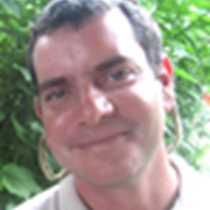Santa Cruz Island
Today we arrived to one of the four inhabited islands that we have in this enchanted archipelago, Santa Cruz Island. Puerto Ayora is a town located right along the sea shore with a population of about 18,000 people.
Here is where the Charles Darwin Research Station is located. Many different studies have taken and are taking place to protect the exceptional wildlife and ecosystems of this remote archipelago. We learned about one of the most important conservation programs, the breeding center of Galápagos Giant tortoises. We observed baby tortoises from one to three years old and several older ones that can be over 100-150 years old. It is very difficult to estimate age in reptiles, mainly because nobody has been living so long to accurately tell it.
In the afternoon we traveled up into the highlands of Santa Cruz for lunch. We had time to relax by a pool and in the beautiful gardens of restaurant Altair. After a succulent lunch we had a big surprise, a huge centipede came out from one the Wellington boots a guest was holding in her hand. We moved further into the giant tortoise’s territory. We spotted a dozen huge giant tortoises moving around and foraging on the grassy hillside and under giant trees. We were able to freely explore the area and experience the tortoises at close range in their natural habitat.
The full day ended with a visit onboard from Roz Cameron from the Charles Darwin Research Station. She told us about the issues and challenges that the Galápagos Islands are facing today, as well as current conservation efforts and hopes for the future of the islands. After dinner we had a golden finale, local musicians and dancers came onboard and cheerfully performed for us.
Today we arrived to one of the four inhabited islands that we have in this enchanted archipelago, Santa Cruz Island. Puerto Ayora is a town located right along the sea shore with a population of about 18,000 people.
Here is where the Charles Darwin Research Station is located. Many different studies have taken and are taking place to protect the exceptional wildlife and ecosystems of this remote archipelago. We learned about one of the most important conservation programs, the breeding center of Galápagos Giant tortoises. We observed baby tortoises from one to three years old and several older ones that can be over 100-150 years old. It is very difficult to estimate age in reptiles, mainly because nobody has been living so long to accurately tell it.
In the afternoon we traveled up into the highlands of Santa Cruz for lunch. We had time to relax by a pool and in the beautiful gardens of restaurant Altair. After a succulent lunch we had a big surprise, a huge centipede came out from one the Wellington boots a guest was holding in her hand. We moved further into the giant tortoise’s territory. We spotted a dozen huge giant tortoises moving around and foraging on the grassy hillside and under giant trees. We were able to freely explore the area and experience the tortoises at close range in their natural habitat.
The full day ended with a visit onboard from Roz Cameron from the Charles Darwin Research Station. She told us about the issues and challenges that the Galápagos Islands are facing today, as well as current conservation efforts and hopes for the future of the islands. After dinner we had a golden finale, local musicians and dancers came onboard and cheerfully performed for us.




